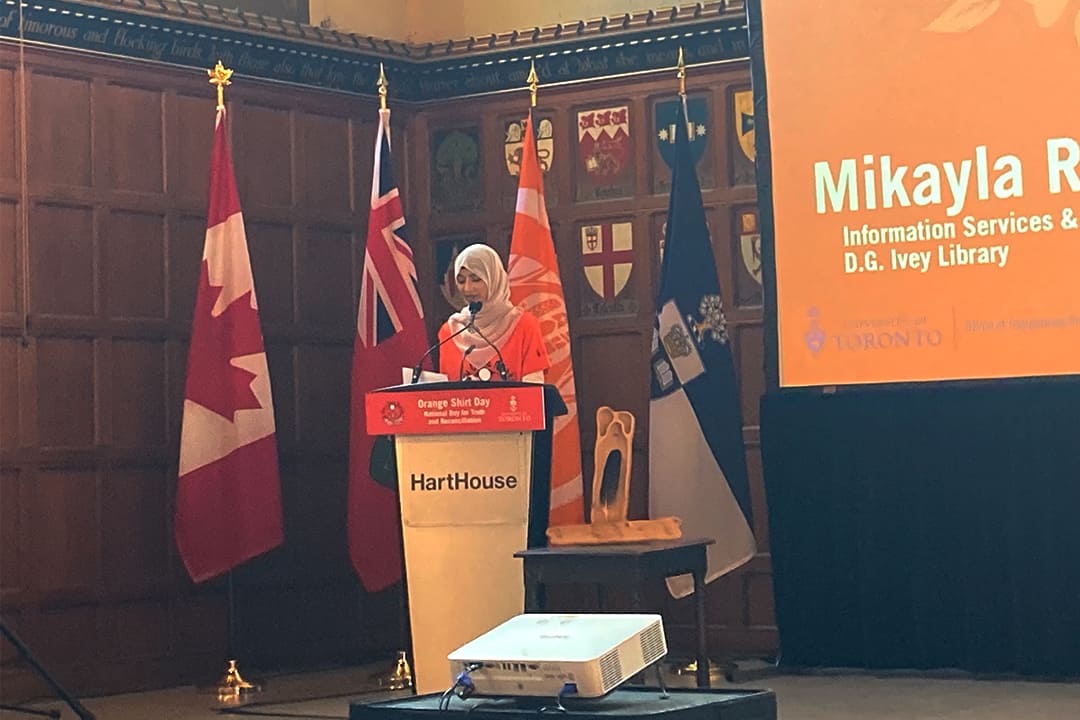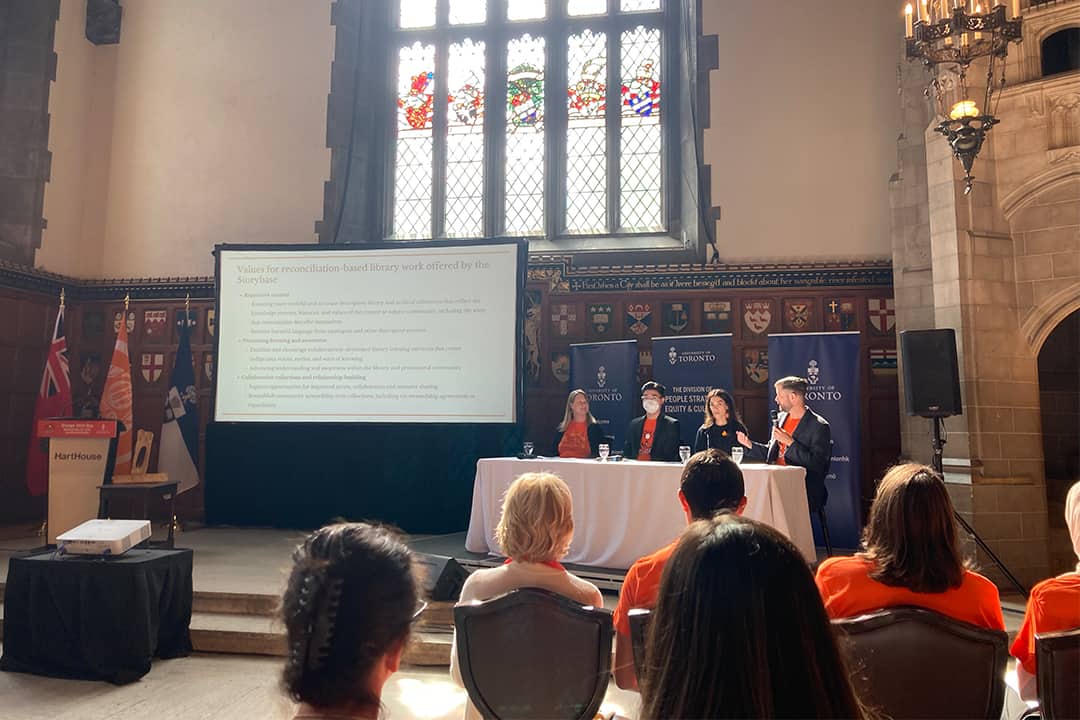Content warning: This article discusses anti-Indigenous racism and the residential school system, and mentions death and sexual assault.
On September 29, U of T held its fourth annual institution-wide event commemorating Orange Shirt Day. The day, observed on September 30, honours Indigenous children who did and did not survive the residential school system and highlights Canadian institutions’ need to actively seek reconciliation.
The ceremony highlighted the Indian Residential School Survivors’ Storybase — a resource created by a team of ten U of T librarians, students, and staff in September — which platforms and organizes stories from residential school survivors. Members of the team participated in a panel discussion, where they talked about the project and how they practiced relational and non-extractive research in creating the Storybase.
“[What] we hope to see a lot of… going forward is more [academic] production that is meeting a need, that is guided by Indigenous communities, that is not quantifying them,” said Mikayla Redden — a New College librarian who is mixed-race, Anishinaabe and Anglo-settler, and a member of Curve Lake First Nation. “We’re interested in… creating a space for people to find stories so that folks can learn the truth and, hopefully, head towards [reconciliatory] action.”
The residential school system
The Canadian government, in partnership with churches, ran more than 140 ‘Indian residential schools.’ The first residential school opened in 1831, and the Canadian government officially started funding the residential school system nationwide by the 1880s.
The schools aimed to assimilate Indigenous kids into white settler society and erase their Indigenous identity by preventing them from speaking their languages or practicing their cultures. The schools also imposed other horrific conditions on children, such as insufficient or spoiled food, sexual assault, forced labour, and inadequate sanitation.
Residential schools in Canada lasted for over 150 years, with the last residential school closing in 1996. In 2015, the Liberal government’s National Truth and Reconciliation Commission (TRC) concluded that the system was a form of cultural genocide.
More than 150,000 Indigenous kids between the ages of four and 16 attended residential schools in Canada. Many children died, with the former head of the TRC estimating in an email to the New York Times that more than 10,000 children had gone missing from residential schools.
The event
Around 10:30 am, a crowd of over 150 people, mostly sporting orange shirts, gathered at the Hart House Great Hall for U of T’s Orange Shirt Day commemoration. The event was also livestreamed online.
In his opening remarks, Hart House Warden David Kim, a settler of Korean ancestry, noted that the planning committee intentionally chose many non-Indigenous speakers and contributors for the event as a way to “engage others and not have the work of the day fall on the shoulders of our Indigenous peers.”

The event featured a panel discussion that included Redden; Desmond Wong, a librarian at the Ontario Institute for Studies in Education and Chinese-Canadian settler; and Grant Hurley, a librarian at the Thomas Fisher Rare Book Library and settler with Irish-Acadian roots.
Redden, who led the Storybase project with Wong, said that the project grew out of discussions with her sister, a primary school teacher who noted that teachers often find it difficult to find resources suitable to educate kids about the residential school system. This is a particular issue for teachers that didn’t learn about residential schools when they themselves were in school, or about best teaching practices on the topic when they were studying to become a teacher.
Redden also said that by giving teachers other resources to educate their students, the project aims to remove some of the extra emotional labour that Indigenous teachers — and Indigenous people generally — tend to do.
The Storybase
The Storybase includes 519 video, audio, and written stories from residential school survivors as of October 7, although the team plans to add more in the future. Users can search based on keywords, the name of a residential school or a survivor, the format of stories, and other factors. The Storybase also includes preselected collections of stories, including one for Orange Shirt Day and one with stories appropriate for K-8 kids.
Wong said that, as a librarian at OISE, he has promoted the Storybase to teacher candidates. The group has also raised awareness about the resource through media interviews, and Wong highlighted that the university has helped promote the project as well.
The welcome page on the Storybase website reminds settlers not to reach out to an Indigenous person to process the grief they feel after listening to, reading, or watching the stories. “We do not want this to become an emotional labour for those most affected by residential schools,” said Desmond.
Instead, the Storybase directs users to channel that grief into action, with a page offering additional learning resources, places Indigenous individuals can receive support, and guides to taking action as a settler.
Wong noted the emotional toll these stories can take on viewers, and the importance of taking breaks when viewing materials. Redden added that her colleagues didn’t ask her to view the stories during the cataloguing process because she is Indigenous, which she characterized as an example of “true, authentic allyship.”
Non-extractive research practices
Hurley highlighted that libraries contain vast amounts of archival material that often depict a one-sided view of Canadian history or treat Indigenous peoples as objects for research.
“We were determined not to contribute to the histories of settler colonialism and extraction within librarianship and instead create new relations based on reciprocity and trust,” said Wong.
The team began by meeting with organizations such as the Legacy of Hope Foundation that provide support to residential school survivors. Based on their meetings, they modeled the Storybase as an index repository, meaning that the Storybase website refers users to pages that include the stories elsewhere on the internet, but does not store them on the website itself. If any survivors or their families request that the librarians remove their story from the Storybase, the librarians will remove the link.
Hurley highlighted a few key guidelines for librarians working with Indigenous communities. He noted that archivists need to change how they contextualize materials, such as by updating their terminology to use words preferred by Indigenous peoples, and giving Indigenous communities access to library collections.
Hurley told the crowd that librarians should work to promote learning that centres Indigenous stories and form relationships with Indigenous communities “that end up benefiting the origin communities more than the library.” He noted that fulfilling this last guideline might include repatriating materials.
Kristina Cổ — a third-year student majoring in criminology and sociolegal studies who attended the event — told The Varsity that she appreciated the event’s emphasis on not putting additional labour on Indigenous people. As someone considering a career in academia, she said, learning about how research institutions have and continue to harm Indigenous communities “makes [her] question the research ethics that I always have to consider.”
If you or someone you know has been affected by the residential school system, you can call:
- Indian Residential School Crisis Line at 1-866-925-4419 (available 24 hours a day),
- Hope for Wellness Helpline at 1-855-242-3310,
- KUU-US Crisis Line at 250-723-4050,
Talk4Healing Help Line at 1-855-554-4325.



No comments to display.